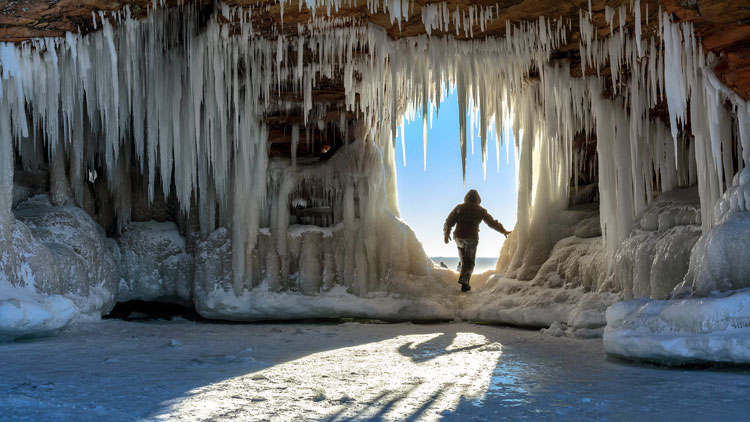
It’s winter, and the air is cold but calm. You’ve just trekked a mile across a frozen section of Lake Superior. You’re ready to explore the ice caves of the Apostle Islands!
These caves are located along the shore of Lake Superior in northern Wisconsin. Over thousands of years, wind and water erosion have carved the caves out of the islands’ sandstone cliffs. (This is still happening!) In winter, freezing waves crash onto the rock, and water between rock layers drips and freezes, causing spectacular ice formations. The ice formations range from giant pillars and large icicles to delicate, needle-like clusters.
Do people really walk a mile across the frozen lake to see these ice caves? Yes, but certain criteria must be met to make sure the ice is strong enough. The ice must be at least 25.4 centimeters (10 inches) thick for at least two weeks. The ice must also be connected, or “locked” between points of land.
Two weather conditions help meet these criteria: cold and calm. It must be cold enough for the ice to freeze and stay solid, but winds must also stay calm. If temperatures drop enough to freeze the lake, strong winds could break up the ice as it freezes, making it rough and jagged.
In the winter of 2014, the conditions were just right. More than 130,000 people trekked across the frozen lake to explore the ice caves. In 2015, however, the ice didn’t stay solid enough to support visitors. Officials at the Apostle Islands National Lakeshore closed the caves early.
As temperatures of Lake Superior’s surface rise, some call the icy adventure an “endangered experience.” One thing is sure to keep happening! Each winter, people in northern Wisconsin will ask, “Will we be able to see the ice caves this year?”
What Do You Think? Think about the term “endangered experience.” How is the experience of seeing the ice caves like an endangered animal?
Photo Credit: Shutterstock / Bryan Neuswanger



